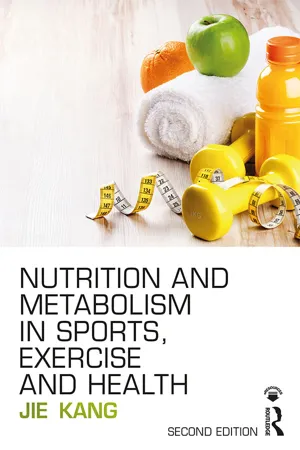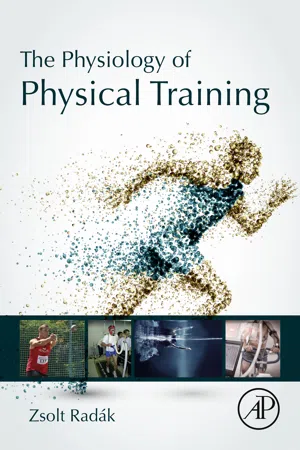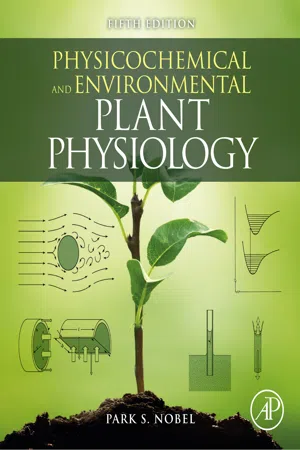Cellular Energetics
Cellular energetics refers to the processes by which cells obtain and utilize energy to carry out their functions. This includes the production of energy-rich molecules like ATP through cellular respiration and the utilization of this energy for various cellular activities such as metabolism, growth, and movement. Cellular energetics is essential for the survival and functioning of all living organisms.
8 Key excerpts on "Cellular Energetics"
- Jie Kang(Author)
- 2018(Publication Date)
- Routledge(Publisher)
...8 Energy and energy-yielding metabolic pathways Contents Key terms Energy • Energy • The first law of thermodynamics • Unit of energy • Potential and kinetic energy • Oxidation and reduction • Biologically usable form of energy Energy consumption • Measurement of energy content of foods • Digestive efficiency • Atwater general factors • Bodily energy stores Energy transformation • The ATP-PCr system (phosphagen system) • The glycolytic system (glycolysis) • The oxidative pathway • Chemiosmotic hypothesis and uncoupling proteins • Oxidation of lipids and proteins • Energy transformation in sports and physical activity Control of energy transformation • Homeostasis and steady state • The control system and its operation • Neural and hormonal control systems Summary Case study Review questions Suggested. reading Glossary Key terms • Acetylcholine • Acetyl-CoA • Adenosine triphosphate • Bioenergetics • Biosynthesis • Catabolism • Chemiosmotic hypothesis • Digestive efficiency • Energy • First law of thermodynamics • Flavin adenine dinucleotide • Glycogenolysis • Glycolysis • Glycolytic system • Homeostasis • Kinetic energy • Lipolysis • Mechanical energy • Negative feedback • Neurotransmitters • Nicotinamide adenine dinucleotide • Norepinephrine • Oxidation • Oxidative phosphorylation • Oxidizing agents • Parasympathetic • Phosphagen system • Phosphocreatine • Phosphorylation • Potential. energy • Redox • Reducing agents • Reduction • Respiratory chain • Second messengers • Steady state • Sympathetic • Uncoupling proteins Energy Energy is required by all cells. In order for you to jump, throw, run, swim, or cycle, skeletal muscle cells must be able to extract energy from energy-containing nutrients such as carbohydrates and fats. Energy is also needed for other bodily functions such as circulation, digestion, absorption, glandular secretion, neural transmission, and biosynthesis, to just name of a few...
- eBook - ePub
Nutrition
CHEMISTRY AND BIOLOGY, SECOND EDITION
- Julian E. Spallholz, Mallory Boylan, Judy A. Driskell(Authors)
- 2018(Publication Date)
- CRC Press(Publisher)
...Cellular Metabolism CHAPTER 10 Body Energy Energy is the capacity to do work. In nutrition, energy expenditure refers to the manner in which the body utilizes the energy obtained via the metabolism of the energy-yielding nutrients carbohydrates, lipids, and proteins. The body is about 40% efficient in capturing the energy from the catabolism of the energy-yielding nutrients. Food energy must be supplied regularly to individuals for their survival and is necessary for the maintenance of human life. The cells of the body do not use the energy-yielding nutrients in the diet for their immediate energy supply. Rather, adenosine triphosphate (ATP), a high-energy compound, is the fuel for energyrequiring reactions. The potential energy stored in ATP molecules provide the chemical energy for biological work. Energy released during ATP hydrolysis activates other energy-requiring molecules. ATP is the “energy currency” of the cell. Slightly over 85 grams of ATP are present in the adult body at any one time. AEROBIC AND ANAEROBIC ENERGY RELEASE Aerobic means oxygen-requiring, while anaerobic reactions do not require oxygen. Energy (ATP) can be released by the cell both aerobically and anaerobically. Energy produced anaerobically can be immediately utilized by the cell and is important in such activities as sprinting and surviving underwater submersion. ENERGY RESERVOIR Creatine phosphate, a high-energy compound, serves as an energy reservoir for the body. Anaerobic hydrolysis of creatine phosphate provides energy for the resynthesis of ATP from adenosine diphosphate (ADP) and inorganic phosphate (P i) forming creatine plus inorganic phosphate (P i). Both of the these reactions are reversible. The cells of our bodies, particularly those of skeletal muscles, are able to store creatine phosphate in larger quantities than ATP. All-out exercise, such as swimming or running, can be maintained for about 6 to 8 seconds utilizing the energy released from creatine phosphate and ATP...
- eBook - ePub
Bioprocess Engineering
An Introductory Engineering and Life Science Approach
- Kim Gail Clarke(Author)
- 2013(Publication Date)
- Woodhead Publishing(Publisher)
...5 Carbon metabolism Abstract: Efficient utilisation of the carbon source impacts significantly on the ability of the microorganism to maintain its cellular integretity, to grow and reproduce and, from the process perspective, to produce the desired product. Since the majority of industrial processes utilise chemo-heterotrophs, only metabolic pathways which utilise organic compounds as their carbon and energy sources will be considered here. The metabolism of chemo- and photo-autototrophs and photo-heterotrophs can be found in specialised texts. Energy generation and utilisation can be classified into catabolism (pathways that generate energy) and anabolism (pathways that utilise energy) such that catabolism supports anabolic cell maintenance and growth. Central to these pathways is the mechanisms of storage of the energy generated during catabolic pathways and the transfer of stored energy to anabolic pathways. This is mediated by the adenosine nucleotides (see Figure 3.7). In Chapter 5, the main catabolic and anabolic pathways in chemo-heterotrophs are detailed and their associated energy generation and utilisation quantified. Further, the mechanisms underpinning the storage of the generated energy and the transfer of the stored energy are elucidated. Key words energy transfer oxidative phosphorylation substrate phosphorylation glycolysis tricarboxylic acid cycle fat oxidation fatty acid synthesis gluconeogenesis 5.1 Energy generation, storage and transfer 5.1.1 The role of adenosine triphosphate The three key nucleotides involved in energy sequestration, storage and release are adenosine triphosphate (ATP), adenosine diphosphate (ADP) and adenosine monophosphate (AMP) containing three, two and one phosphate group(s) respectively (see Figure 3.7)...
- eBook - ePub
- Zsolt Radák(Author)
- 2018(Publication Date)
- Academic Press(Publisher)
...Lipid metabolism is more efficient compared to carbohydrates since lipids contain six times more energy than the same amount of glycogen. All the glycogen stored in the cells can be burned in 1 day, whereas lipid storage is able to provide energy for a month. Thus, mitochondria play an important role in energy-producing processes and ATP production (Fig. 1.4). Fig. 1.4 Mitochondria. Mitochondria are an ATP-producing unit of the organism, and also play a role in programmed cell death and adaptation following physical training. In skeletal muscle, subsarcolemmal (below the membrane) and intermyofibrillar (close proximity to myofibrils) mitochondria are distinguished based more on their locations in the cell and less on their function. The number of mitochondria can be elevated significantly by physical training. This will be addressed in detail in Chapter 2. Another important organelle of the cell is lysosome containing digestive enzymes, which break down proteins. These enzymes play a role in balancing the metabolism and catabolism of proteins. This balance is an important part of cellular homeostasis. 1.2 Cellular Adaptation Upon stimulation, the cell responds to the stimulus with changes in protein synthesis. On the cell surface there are many sensors embedded in the membrane. Upon stimulation, two types of responses are possible. If a stimulus is extremely strong, and the cell cannot maintain its function, it induces a signal, which leads to the synthesis of proteins involved in programmed cell death, called apoptosis. This process results in cell shrinkage and degradation of nuclear chromatin. The remaining degraded molecules can be used for biological processes. Apoptosis is a part of the defense system of the cell—for example, cells containing damaged or mutated DNA are eliminated through apoptosis, reducing the chance of the development of cancer (Fig. 1.5). Fig. 1.5 Programmed cell death...
- eBook - ePub
Essential Physiological Biochemistry
An Organ-Based Approach
- Stephen Reed(Author)
- 2013(Publication Date)
- Wiley(Publisher)
...Fortunately, the mathematical knowledge required to understand metabolic processes is fairly straightforward and the skills we will use in this chapter are little more than those of basic arithmetic, the occasional use of logarithms and the confidence to rearrange a formula. The commonest failing is not with the computation, but a failure to take appropriate care with use of units. The most important understanding to be gained from this chapter is how to interpret the data rather than how to generate them. 2.2 Bioenergetics: the application of thermodynamic principles to biological systems The study of energy changes occurring in cells is fundamental to a sound understanding of metabolism, but it is also one which students often find the most challenging. The difficulties arise due to the conceptual nature of the topic and of the terms used to describe it. Whilst it is easy to picture in one’s mind eye the basic structure of a metabolic intermediate such as glucose or cholesterol and one can easily imagine a small amount of, say, the amino acid alanine in the palm of the hand, to conjure up an image of energy is not so easy. By virtue of their very existence, all substances are considered to possess energy. The amount of energy will however vary from one compound to another due to the nature and number and type of atoms within a molecule and the chemical bonds which hold those atoms together. During any chemical reaction, the total energies of the individual reactants will become redistributed: some part of the total is used, for instance, to make and break chemical bonds; some of the overall energy may be ‘lost’ (transferred) to the environment. Occasionally we encounter reactions in which the total energy of the reactants is insufficient to initiate the reaction...
- eBook - ePub
Biology
A Self-Teaching Guide
- Steven D. Garber(Author)
- 2020(Publication Date)
- Jossey-Bass(Publisher)
...5 Cellular Respiration Cellular respiration 7777is a series of chemical reactions that frees the energy in fat, protein, and carbohydrate food molecules, rendering it available to the cells (see Figure 5.1). Respiration is generally defined as the oxygen-requiring stage in these biochemical reactions. However, in certain instances, respiration also occurs without any oxygen; this is known as anaerobic respiration. During respiration, as in photosynthesis (described in Chapter 6), each chemical reaction is catalyzed by an enzyme. To break down glucose molecules, which are the stable end products of photosynthesis, adenosine triphosphate (ATP) is needed to provide the activation energy to initiate the chemical processes that follow. ATP is one of the major energy-providing molecules that initiate biochemical reactions throughout the body. Because ATP, NADH 2, and similar molecules are essential to the maintenance of living systems, organisms need to ensure the constant supply of such energy sources. See Figure 5.2 for the role of enzymes in reducing activation energy, and Figure 5.3 for the role of temperature in enzyme activity. GLYCOLYSIS Each time we eat, our cells break down glucose in our food. The breaking down of glucose involves a process called glycolysis. Glycolysis is the first series of chemical reactions in cellular respiration, in which glucose is converted to pyruvate (pyruvic acid), which is a transport molecule that carries carbon atoms to the mitochondria where oxidation creates molecules that are used for energy, and in the process, carbon dioxide is created. This is why our metabolic processes produce so much carbon dioxide...
- Wei-Shou Hu(Author)
- 2020(Publication Date)
- CRC Press(Publisher)
...3 Cell Physiology Contents Introduction Glucose and Energy Metabolism Oxidation of Glucose Pentose Phosphate Pathway (PPP) Lactate Formation Carbon Flow and the Supply of Biosynthetic Precursors Regulation of Glucose Metabolism Isozymes and Allosteric Regulation Combination of Isozymes Gives Pathway Specific Characteristics Key Isozymes in Regulating Glucose Metabolism Growth Control and Metabolic Regulation Transport and Transporters Glucose Transporters Lactate Transporters Mitochondrial Pyruvate Carrier (MPC) Metabolic Homeostasis and Lactate Consumption States of Glucose Metabolism NADH Balance Malate-Aspartate Shuttle Other Carbon Fluxes across the Mitochondrial Membrane Amino Acid Metabolism Glutamine and Its Role in Energy Metabolism Amino Acid Metabolism Amino Acid Transport Amino Acid Degradation and Growth Inhibition Lipid Metabolism Lipid Transport Fatty Acid Metabolism Cholesterol and Its Biosynthesis Glycan Biosynthesis and Protein Glycosylation Glycan Heterogeneity Major Types of N-Glycans Role of Glycans Protein Folding and Glycosylation in the ER Glycan Extension in the Golgi. Apparatus O-Glycosylation Synthesis and Transport of Nucleotide Sugar Precursors Glycan Diversity among Species Concluding Remarks References Introduction Cells in culture take up sugar, amino acids, lipids, and nucleosides from their growth medium. They metabolize these compounds to derive energy and use them to generate more cell mass, divide into more cells, and produce products. Proteins, which are polymers of amino acids connected by peptide bonds, constitute over 50% of the dry mass in a typical cell. Protein synthesis is an energetically costly process. Each peptide bond costs at least 3 ATP, which is nearly 1/10 of the energy generated by the oxidization of one glucose. A high-producing recombinant cell may produce over 40 pg per day of IgG protein. Each cell has about 400 pg of cell mass (or about 200 pg of cellular proteins) and can double its biomass in a day...
- Park S. Nobel(Author)
- 2020(Publication Date)
- Academic Press(Publisher)
...6 Bioenergetics 6.1. Gibbs Free Energy 6.1A. Chemical Reactions and Equilibrium Constants 6.1B. Interconversion of Chemical and Electrical Energy 6.1C. Redox Potentials 6.2. Biological Energy Currencies 6.2A. ATP—Structure and Reactions 6.2B. Gibbs Free Energy Change for ATP Formation 6.2C. NADP + –NADPH Redox Couple 6.3. Chloroplast Bioenergetics 6.3A. Redox Couples 6.3B. H + Chemical Potential Differences Caused by Electron Flow 6.3C. Evidence for Chemiosmotic Hypothesis 6.3D. Coupling of Flows 6.4. Mitochondrial Bioenergetics 6.4A. Electron Flow Components—Redox Potentials 6.4B. Oxidative Phosphorylation 6.5. Energy Flow in the Biosphere 6.5A. Incident Light—Stefan–Boltzmann Law 6.5B. Absorbed Light and Photosynthetic Efficiency 6.5C. Food Chains and Material Cycles 6.6. Summary 6.7. Problems 6.8. References and Further Reading Throughout this book we have considered various aspects of energy in biological systems. The concept of chemical potential was introduced in Chapter 2 and applied to the specific case of water. In Chapter 3 we used this thermodynamic approach to discuss the movement of ions. We also considered the use of energy for the active transport of substances toward higher chemical potentials. Chapter 4 dealt with the absorption of light, an event that is followed by various deexcitation reactions for the excited states of the molecules. The photochemistry of photosynthesis discussed in Chapter 5 involves the conversion of such electromagnetic energy into forms that are biologically useful. This last aspect—the production and the use of various energy currencies in biological systems—is the topic of this chapter. The two energy “currencies” produced in chloroplasts following the trapping of radiant energy are ATP and NADPH. These substances represent the two main classes of energy-storage compounds associated with the electron transfer pathways of photosynthesis and respiration...







